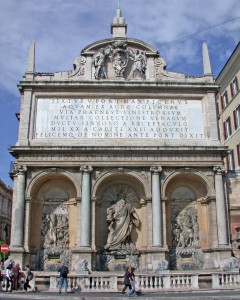 Fendi, one of Italy’s most famous and respected fashion houses, will finance the restoration of four symbolic fountains in Rome—an announcement which follows Fendi’s recent financing of the Trevi Fountain restoration and renovation of Quattro Fontane.
Fendi, one of Italy’s most famous and respected fashion houses, will finance the restoration of four symbolic fountains in Rome—an announcement which follows Fendi’s recent financing of the Trevi Fountain restoration and renovation of Quattro Fontane.
The latest fountains to get some stylish funds invested will be the Janiculum Fountain, the Fountain of Moses, the Fountain of the Nymph and the Peschiera Fountain. Each has a storied role in Rome’s past.
The Janiculum Fountain, sometimes known as the Fontanone, or “Big Fountain,” is formally the Acqua Paola at the top of Janiculum Hill’s San Pancrazo gate. It forms the terminus of the Acqua Paola aqueduct, which Pope Paul V restored between 1608 and 1610. The Janiculum Fountain appears in the opening sequences of Paolo Sorrentino’s 2103 Oscar-winning film The Great Beauty.
The Fountain of the Nymph on the Pincio Hill is one of the symbolic works of Italian Neoclassical architect and urban designer Giuseppe Valadier (1762-1839). The Fountain of Moses in Piazza San Bernardo was erected between 1585 and 1589 as a display for the terminus of the Acqua Felice aqueduct, designed by Giovanni and Domenico Fontana. The Peschiera Fountain in Piazzale degli Eroi, built of masonry, travertine and cement in 1949 in view of the 1950 Jubilee or Holy Year, is the terminus for the Peschiera aqueduct, considered one of Europe’s largest.
“This is Fendi’s act of love for Rome,” said Fendi President and CEO Pietro Beccari when the Trevi Fountain was turned back on earlier this week after months of being covered in scaffolding. ”Since the house was founded in 1925, Rome has been an inexhaustible source of inspiration for Fendi…its fountains are one of the symbols of the capital, but also a recurring theme in our history,” he said.
Not everyone has been completely enthusiastic about the Fendi-funded restorations. The New York Times reported that since the government has traditionally been responsible for maintaining historical sites in Italy, some historians and preservationists worry that the shift could lead to crass commercialization.
Critics complain that companies have exploited cultural sites by commandeering them for elaborate dinners or the display of luxury advertisements. Indignation ran high in Florence after it was discovered that city officials had allowed Morgan Stanley to hold a dinner inside a 14th-century chapel for a rental price of $27,000.
Florence’s mayor doubled the rent to $54,000 after the outcry, but some argued that price was not the core issue. “There are sacred places where one can simply not hold a dinner,” said Salvatore Settis, an expert in cultural heritage law and a former director of the J. Paul Getty Research Institute in Los Angeles.
Perhaps Fendi is wise to focus on fountains, places less likely to be rented out for gala dinners, in its attempts to give back to The Eternal City.
By Kathy McCabe
 Want to read more about travel? Get your free copy of our new digital magazine, Perillo Traveler!
Want to read more about travel? Get your free copy of our new digital magazine, Perillo Traveler!
